A relation is any set of ordered pairs.
A function is a set of ordered pairs where no two first values are the same.
To determine whether a set of ordered pairs is a function or a relation:
- Look at the first numbers in the ordered pairs
- If all of the first numbers are different, then the set of ordered pairs is a function
- If any two first numbers are the same, then the set of ordered pairs is a relation
Examples: Identify each set of ordered pairs as a relation or a function. List the domain and range.
Reasoning
- {(-4,3),(5,6),(-4,8),(5,-3)}
Relation
Domain: {-4,5}
Range: {-3,3,6,8}
Look at the first numbers or the
x-values in the ordered pairs
Since there are two -4s, and two 5s, the set of ordered pairs is a relation
List the domain or x-values
as {-4,5} because we list each number just once and in ascending order
List the range or y-values
as {-3,3,6,8} because we list the numbers in ascending order
- {(-2,6),(-1,5),(0,6),(1,5)}
Function
Domain: {-2,-1,0,1}
Range: {5,6}
Look at the first numbers or the
x-values in the ordered pairs
Since all the x-values are different, the set of ordered pairs is a function
List the domain or x-values
as {-2,-1,0,1} because we list the numbers in ascending order
List the range or y-values
as {5,6} because we list each number just once and in ascending order
Graphic representation of a function and a relation
We can also determine whether a graph represents a relation or a function by looking at the graph’s ordered pairs. In fact, we can tell whether a graph is a function or a relation by just looking at the graph. This is called the vertical line test.
If a vertical line passes through more than one point of a graph, then it is a relation.
If a vertical line does not pass through more than one point of a graph, then it is a function.
Reasoning: All ordered pairs on the same vertical line have the same x-value.
Example: Identify each graph as a function or a relation.
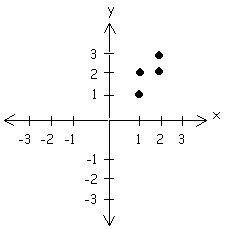
Relation
Reasoning
The graph is a relation because we can draw a vertical line through more than one point
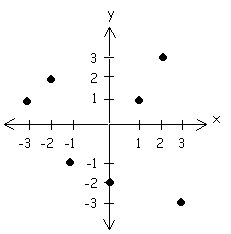
Function
Reasoning
The graph is a function because any vertical line would pass through only one point
Function values of a function
Functions can also be expressed as equations. Because of that, we can find values of functions.
The equations that we will work with will be of the form
y = ax + b and y = ax2 + bx + c.
When we are asked to find the value of a function, we express the functions as f(x) = ax + b and f(x) = ax2 + bx + c, where f(x) = y and tells us to find the value of the function (y) for the given value of x.
f(x) is read "f of x".
Examples: If f(x) = 2x - 5, find:
Reasoning
- f(2)
f(2) = 2(2) - 5
f(2) = 4 - 5
f(2) = -1
f(2) tells us to substitute 2 in for x and then simplify
In 2(2) - 5, we multiply first to
get 4 - 5 then add to get -1
- f(-3)
f(-3) = 2(-3) - 5
f(-3) = -6 - 5
f(-3) = -11
f(-3) tells us to substitute -3 in for x and then simplify
In 2(-3) - 5, we multiply first to
get -6 - 5 and then add to get -11
By finding the values of the function, we can express a set of ordered pairs because f(x) = y.
Since f(2) = -1, y = -1 for (2,-1)
Since f(-3) = -11, y = -11 for (-3,-11)
Remember: When raising a number to a power, the exponent tells us the sign of our answer. If the exponent is even, then the answer is positive. If the exponent is odd, then the answer is negative.
Example: If f(x) = x2 - 3x + 2, find
Reasoning
- f(-1)
f(-1) = (-1)2 - 3(-1) + 2
f(-1) = 1 + 3 + 2
f(-1) = 6
f(-1) tells us to substitute -1 in for x
In (-1)2 - 3(-1) + 2, order of operations tells us to do the power and multiplication first 1 + 3 + 2 and then add to get 6
- f(4)
f(4) = (4)2 - 3(4) + 2
f(4) = 16 - 12 + 2
f(4) = 6
f(4) tells us to substitute 4 in for x and then simplify
In (4)2 - 3(4) + 2, order of operations tells us to do the power and multiplication first 16 - 12 + 2 and then add to get 6
Determining the ordered pair solution of a function
A solution of a function is an ordered pair that makes a true sentence. As a result, we can tell whether an ordered pair is a solution by substituting the ordered pair into the equation and determining whether it makes a true sentence.
Example: Determine whether the following ordered pairs is a solution to y = 3x - 5:
Reasoning
- (-3,4)
4 = 3(-3) - 5
4 = -9 - 5
4 ≠ -14
(-3,4) is not a solution
Substitute the 4 in for y and
the -3 in for x
Simplify by multiplying first
3(-3) - 5 = -9 - 5 then adding
-9 - 5 = -14
4 is not equal to -14, so (-3,4) is not a solution
- (4,7)
7=3(4)-5
7=12-5
7=7
(4,7) is a solution
substitute the 7 in for y and
the 4 in for x
Simplify by multiplying first
3(4) - 5 = 12 - 5 then adding
12 - 5 = 7
7 is equal to 7, so (4,7) is a solution
Try these problems:
Identify if each set of ordered pairs is a relation or a function. List the domain and range.
- {(-3,8),(-2,5),(3,7),(5,-1)}
- {(4,3),(5,-2),(4,-4),(5,7)}
Identify the following graphs as a relation or a function.
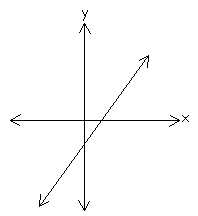
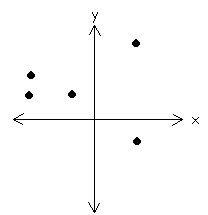
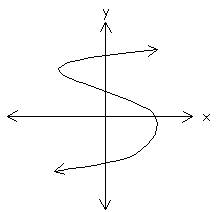
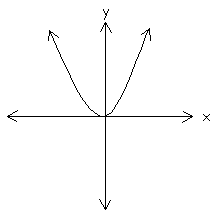
Identify if each set of ordered pairs is a relation or a function. List the domain and range.
- {(-3,8),(-2,5),(3,7),(5,-1)}
- {(4,3),(5,-2),(4,-4),(5,7)}
Identify the following graphs as a relation or a function.



Do the following tables represent a relation or a function? Express the table as a set of ordered pairs. List the domain and range.


Problem Solving - If you have pieces of paper in one box with the numbers 0, 1, 2, 3, 4 and pieces of paper in a second box with the numbers 5, 6, 7, 8, 9, explain how you could form five ordered pairs that would represent a function. Explain your reasoning.
Answers to Practice Problems
- Function
Domain: {-3,-2,3,5}
Range: {-1,5,7,8}
- Relation
Domain: {4,5}
Range: {-4,-2,3,7}
- Function
- Relation
- Relation
- Function
- Relation
{(-5,7),(3,7),(-5,2),(3,2)}
Domain: {-5,3}
Range: {2,7}
- To make sure that I would have five ordered pairs that represent a function,
I would draw a number from the first box and then a number from the second
box and pair them together. I would continue to do this until all five numbers
from the first box are paired with a number from the second box.
Find the value of the function f(x) = 2x - 5 for:
- f(-2) =
- f(0) =
Find the value of the function f(x) = 2x2 - 4x + 7 for:
- f(-2) =
- f(0) =
Determine if each ordered pair is a solution for y = -2x + 3:
- A = (-2,7)
- B = (3,6)
Determine if each ordered pair is a solution for y = x2 - 2x + 3:
D = (1,2)
E = (-2,11)
Answers to Practice Problems
- f(-2) = 2(-2) - 5
f(-2) = -4 - 5
f(-2) = -9
- f(0) = 2(0) - 5
f(0) = 0 - 5
f(0) = -5
- f(-2) = 2(-2)2 - 4(-2) + 7
f(-2) = 2(4) + 8 + 7
f(-2) = 8 + 8 + 7
f(-2) = 23
- f(0) = 2(0)2 - 4(0) + 7
f(0) = 2(0) + 0 + 7
f(0) = 0 + 0 + 7
f(0) = 7
Determine if each ordered pair is a solution for y = -2x + 3:
- A = (-2,7)
7 = -2(-2) + 3
7 = 4 + 3
7 = 7
(-2,7) is a solution
- B = (3,6)
6 = -2(3) + 3
6 = -6 + 3
6 ≠ -3
(3,6) is not a solution
Determine if each ordered pair is a solution for y = x2 - 2x + 3:
- D = (1,2)
2 = (1)2 - 2(1) + 3
2 = 1 - 2 + 3
2 = 2
(1,2) is a solution
- E = (-2,11)
11 = (-2)2 - 2(-2) + 3
11 = 4 + 4 + 3
11 = 11
(-2,11) is a solution